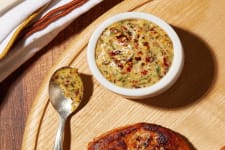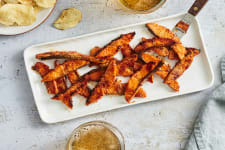
Kimbap with Flaked Salmon and Salted Cucumbers
June 22nd, 2022A Kimbap Recipe Made with Flaked Salmon
Kimbap is sometimes casually (though inaccurately) referred to as “Korean sushi,” since it resembles the maki rolls you’d get at your favorite sushi spot. Our salmon kimbap recipe is made with flaked fish, salted cucumbers, kimchi, and avocado for a fresh and filling lunch or casual afternoon snack.
Unlike sushi, kimbap is filled with cooked ingredients instead of raw fish — making this salmon recipe a perfect way to use up any cooked wild-caught seafood and veggies you have in your fridge. Try rolling up your kimbap with whatever combination of ingredients sounds good to you.
How to Enjoy Leftover Kimbap
Kimbap is meant to be consumed shortly after being prepared. When stored in the refrigerator, the rice tends to dry out. However, it can easily be revived after being dipped in whisked egg then fried, making this a good recipe option for meal preppers.
This kimbap recipe makes about 4 servings of kimbap. If you know that you’re only going to eat 1 serving after it’s been made, we still suggest making the full recipe. From there, use only what you need to make one or two rolls, and save the rest of the ingredients to make our recipe for Salmon Fried Rice with Garlicky Cucumbers or a Ginger-Lime Salmon Poke Bowl using freshly steamed or reheated rice.
Kimbap with Salmon and Salted Cucumbers
By Wild Alaskan Company
A quick Korean lesson: "Kim" means seaweed, and "bap" means rice.
Prep time
10 minutes
Cook Time
15 minutes
Total time
25 minutes
Yield
4 servings
Ingredients
- 1 (6 oz.) portion Sockeye or Coho Salmon, cooked and flaked
- 1 cup short-grain rice, raw
- Salt
- 2 tablespoons plus 1 teaspoon sesame oil, divided
- 1 teaspoon garlic, minced
- 2 medium cucumbers, very thinly sliced
- ¼ cup soy sauce
- 1 tablespoon rice wine vinegar
- 2 tablespoons lime juice
- ½ teaspoon fresh ginger, freshly grated
- 6 sheets roasted seaweed (“kim” for kimbap, or nori)
- 1 cup kimchi, chopped
- 1 ripe avocado, sliced
- 2 scallions, thinly sliced
- Sesame seeds
- 1 egg, optional, for reheating
Instructions
1. In a medium bowl, combine cucumber with 2 teaspoons of salt, tossing to coat. Allow to sit for at least 15 minutes, then rinse and drain. Taste to check for salt level. If too salty, rinse and drain again. Squeeze out any excess moisture when cucumbers are seasoned to your taste, then toss with garlic and 2 teaspoons sesame oil.
2. Rinse rice in a few changes of water, then cook according to package directions. Once cooked, stir in 2 teaspoons sesame oil and ¼ teaspoon salt and set aside until just cool enough to handle.
3. Meanwhile, whisk together soy sauce, remaining tablespoon sesame oil, vinegar, lime juice, and ginger in a medium bowl. Stir in flaked salmon, tossing to coat. Set aside.
4. Once rice, cucumbers, and salmon are ready, assemble the kimbap. Lay a sheet of seaweed shiny side down onto a flat surface and spread ½ cup of rice over the seaweed, leaving an inch or two bare on one long end of the sheet. Lay about 2 to 3 tablespoons each of the flaked salmon, cucumbers and kimchi in horizontal rows over the rice, along with a few slices of avocado and scallions. Sprinkle with sesame seeds, then tightly roll. If needed, use water or extra grains of rice as “glue” to help seaweed adhere to itself as a roll. Repeat with remaining ingredients until you’ve assembled 5 to 6 rolls.
5. Brush exterior of rolls with sesame oil, then use a sharp, lightly oiled knife to slice rolls into approximately ¼-inch coins. Clean off knife as needed while slicing to get the cleanest cuts. Enjoy immediately, or keep covered at room temperature for up to 2 hours. Leftovers can be refrigerated and reheated after being dipped in whisked egg and fried in a little oil over medium heat until golden.
6. Alternatively, refrigerate leftovers in a covered container. When ready to enjoy, dip pieces into whisked egg and fry over medium heat for a couple minutes on each side or until golden.
Consuming raw or undercooked meats, poultry, seafood, shellfish, or eggs may increase your risk of food-borne illness, especially if you have a certain medical condition. The FDA recommends an internal temperature of 145°F for cooked fish.





